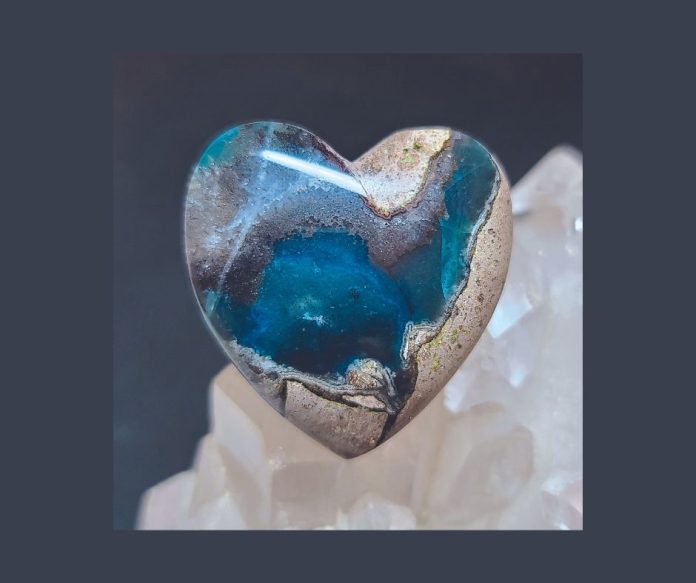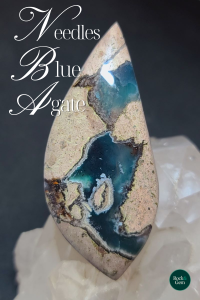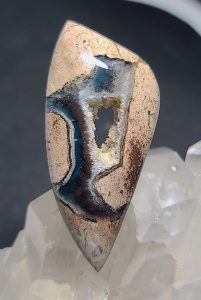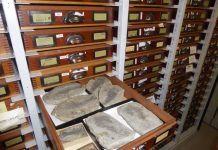
Needles blue agate is a gem silica chalcedony that comes from the Blue Danube Mine near Lake Havasu. Its blue coloring comes from the copper minerals, where the agate has filled in the cracks of its rhyolitic host stone.
As with most chalcedony materials, you can run across features, such as sagenites, fortifications and drusy pockets, as well as colorings from other copper minerals such as cuprite (red) and malachite (green). Much of the gem silica running through the host stone is very thin, usually up to .25 inches wide. On occasion, you can cut into pieces that have wonderful large blue pockets of gem silica ranging up to the size of a quarter.

Finding Needles Blue Agate
In the past several years, this material has become rare and more hard to find. The claim has been off-limits for years. To my knowledge, it was run by the Needles Gem & Mineral Club. As long as you were a member, you were allowed to dig and bring a guest. To obtain material now, you can still find some at shows and various online lapidary sales venues.
Slabbing Needles Blue Agate
To start the slab process, there’s no right or wrong direction to cut. The best thing to do is find where all the visible blue veins are, then start cutting to maximize the gem silica in your slabs. With each cut, the slabs will change patterns and you might lose the vein and be forced to reload the saw in a different direction. It might be best to cut it in half, or into smaller chunks to be able to hand-cut the rest on a trim saw, making it easier to see and change directions when needed.
I find smaller pieces to be the best value for your money. You can easily see what you are getting and you will be able to hand cut it on a 10-inch trim saw with a thin blade for the most yield.
After each slab is cut, I suggest putting them in a dish or bucket of water, to keep the gem silica from fracturing, or cracking after it’s been exposed to the air.
Once your slabs are cut, and you are preparing them to trim out your preforms, you should examine all the blue areas around the rhyolite host stone. Be sure there are no visible separations between the agate and the rhyolite. Sometimes the two materials like to break apart at the seam. This is where you may want to use some type of treatment (gluing compound) or vacuum-stabilize the slabs before going any further.
 Cabbing Needles Blue Agate
Cabbing Needles Blue Agate
The cabbing process for Needles blue agate is rather easy but there can be a couple of pitfalls. The first is the agate and host stone separating from each other. The second is the hardness difference between the host and agate. Rhyolite is much softer and tends to undercut. The rhyolite will also have variances of hardness and you can run into some very soft spots that grind away in a hurry.
When starting to cab, preform on an 80-grit steel wheel and get a good feel of the rhyolite making sure it’s all the same hardness. Then move forward to either a 220-steel grit wheel or a 28-grit soft resin wheel. This is where you want to focus attention on the agate portions trying to smooth the cab and remove all the scratches. Focusing on the agate will help to keep from undercutting the rhyolite and leaving an uneven dome on the surface of your cabochon.
Finishing Up
From this point, it’s rather routine, moving to the 600, 1200 and 8k-grit soft resin wheels. After that, you should have a beautifully polished cab. The agate will polish to a mirror finish but only expect the rhyolite to polish up to a glossy finish at best.
After you have finished on the cabochon machine, you can hand polish your cab with cerium oxide, or Zam polishing compound on a foredom, or Dremel tool with a soft felt tip. Be sure to polish in short spurts and continue to check the cab, making sure not to overheat the material as it will fracture easily.
This story about Needles Blue Agate previously appeared in Rock & Gem magazine. Click here to subscribe. Story by Russ Kaniuth.















